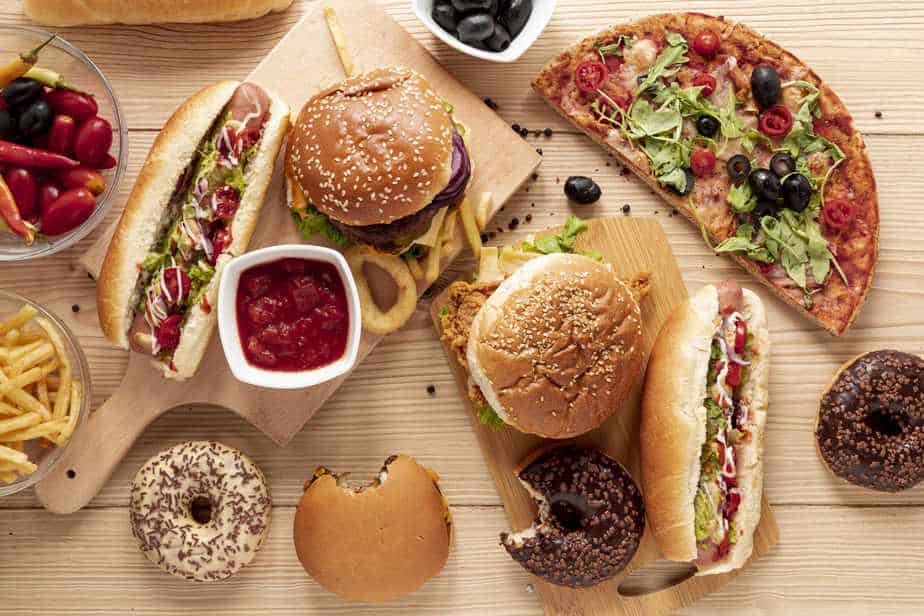Determining if you have a food allergy or sensitivity doesn’t have to cost you in terms of doctor appointments and lab testing. You can even buy an online food sensitivity kit that can run you around $139 – $600, depending on who you use.
Or you can save your money and try an elimination diet. It is possible to figure out your food intolerance or sensitivity without spending money on testing.
It’s required by the FDA that food manufacturers list the top 8 allergens on the label.
Top 8 Food Allergens
Milk
Eggs
Peanuts
Tree nuts
Fish
Shellfish
Soy
Wheat
Doing an elimination diet can help you in determining your reactive culprits such as milk, eggs, peanuts, tree nuts, fish, shellfish, soy, and wheat. You may have noticed these items on the back of food listed under the food ingredient list stating May Contain or Contains and then the allergen.
How Do You Know If You Have an Allergy to One of These Foods?
You may experience some symptoms after ingesting or eating these particular foods. Some reactions may be minor and difficult to link to a food allergy, and others may be severe and cause anaphylaxis.
There are tests out there that can easily tell you which foods you are allergic too. Your doctor can order these tests and review your results with you. This the recommended approach if you have a severe or strong reaction to a food allergen. Better to get a doctor involved to help with addressing this allergy and/or prescribing an epi-pen if needed.
If you experience mild symptoms and are curious as to which food is causing your reaction, a simple elimination diet can help you decipher the allergen.
All you need to invest in is paper, pen, and mindfulness.
Elimination Diet Process
I recommend starting the process by first keeping a food journal. It doesn’t have to be anything fancy, just a piece of paper will do. Write down everything you eat. Everything.
Start with the date, description of the meal, what possible allergens are in the foods you’re eating, and then the reaction.
You can use the ShopWell app (not an affiliate, but I use it) to help you quickly read ingredient labels and alert you of any of these allergens.
You’ll do this for about two weeks. You’re collecting data on yourself to see if anything jumps out at you.
My second recommendation is to only eat your meal and stop. Don’t eat your meal, then snack on something shortly after, and forget to log it into your food journal. This will keep you from knowing the true source of what caused your reaction.
For instance, I would eat my lunch/dinner, as I do intermittent fasting, and once I’m done, I’m done. Nothing else to eat, and I only drink water after for at least 2 hours.
Why Two Hours?
Because it can take up to 2 hours to trigger your allergic reaction. My allergic reactions happen almost precisely one and a half hours after I’ve eaten my food. For me, that means my eyes start watering, and congestion ensues.
Some of you may experience symptoms immediately after ingesting the allergen others may experience a reaction within 30 minutes. Everyone is different, but it can take up to 2 hours to have the reaction.
After two weeks of keeping a food journal, look back at it and review which allergens are present in the foods you ate. Did you have a reaction to that food or not? If you did, what was the reaction? Did this reaction happen every time you ate that allergen?
Now you’re starting to put the pieces together. Now, based on your data/food journal, you can determine which allergen gave you an allergic reaction.
If it was milk, wheat, or soy, or others then this is where your elimination diet will begin.
If you have multiple allergens that can be possible culprits, you’ll start with the one that gave you the most symptoms. Begin with eliminating this allergen first. Then remove the next allergen.
How Do You Eliminate These Allergens?
You start with reading food ingredient labels. Check everything in your pantry and fridge that you eat and regularly use to see if it contains the food allergen. You may find that it will be in a lot of the food that you already have on hand.
Next, find alternatives to these products and foods that do not contain the allergen. Either make it or find an alternative to buy.
To make it easier on yourself, find recipes on Pinterest, or google for meal ideas and alternatives. To avoid an extra grocery bill, try to use the allergen-free items that you have on hand first and create meals from these items, if possible.
Remember to still log your meals in your food journal. I’ve found that even when I thought I eliminated all the soy from my meal, I still had a reaction. This causes me to go back and recheck everything I just ate and recheck the ingredient labels again.
During these times, I either overlooked or didn’t recognize a soy ingredient name (tricky little suckers) by accident. This was the culprit.
Track Your Positive and Negative Results
Make any notes you need to remember your reactions or not, and note how you feel every day. Are you feeling less brain fog, have more energy, bloating disappearing, are you breathing easier? Be mindful of your positive reactions as well. This is equally as important as adverse reactions.
After two weeks’ worth of data/food entries from the elimination diet, check-in with yourself to see how you’re feeling. Are you having any negative reactions to foods? If you’ve stuck with the elimination process, you can now try to eat something that has the said allergen you’re avoiding?
Log the meal into your food journal and mark the food allergen you’re are reintroducing.
Wait the full two hours after that meal and see if you notice any symptoms/reactions. If you’re doing this elimination diet after detox for 3-5 days, you may notice the effects as soon as you ingest the allergen foods.
What If You Have an Immediate Reaction After Consuming the Food Allergen?
This means you have identified your food sensitivity or food intolerance. Once you’ve had this reaction go back to your elimination diet for a few more days and try another food item with the same allergen. Wait and see if you have the same reaction.
If you have the reaction to this food allergy again, you more than likely have a food sensitivity/intolerance to this ingredient. You can experiment with this over the course of a week to make sure.
Symptoms When Reintroducing Possible Allergens May Include
Headaches
Bloating
Stomach cramps or pain
Rash or hives
Joint Point
Congestion
Runny nose
Watery eyes
Coughing
Wheezing or changes in breathing.
For those who have multiple food allergens to go through, you will do this for each food allergen. After eliminating the first allergen and identifying it, remove that allergen and remove the next allergen on your list from your food.
In this case, you’ll be on your original elimination diet plus removing an additional food allergen. This can get tricky when it comes to eliminating more foods. BUT, stay with it even if it’s hard to find alternatives. You may have to make food or stick with whole foods and grass-fed meats.
Remember, if you have a soy allergy, eating grass-fed meats makes a difference in your allergy. The animal feed given to cattle may contain soy and therefore is in the meat you are eating. I noticed the difference after making the change to grass-fed. Plus, the beef was umpteenth times better in taste.
You’ve Identified the Food Allergens, Now What?
You finished the elimination diet and have now determined what has been causing your stomach upset, indigestion, watery eyes, runny nose, and the list goes on. This is excellent news!
Now you adapt to your new life of eating Soy-free, Gluten-Free, Wheat-Free, Egg-Free, Nut-Free, Dairy-Free, or what have you.
At this point, it should be a little easier to keep with eating this diet. You’ve been at it for a few weeks now and have reaped the benefits.
You’re feeling better, clear-minded, have more energy, you may have lost weight and are feeling really good.
The last step is continuing to learn new recipes that adapt your new allergen-free way of eating. You can venture out of your box and start making alternatives to your favorite meals. This is just the beginning of feeling better.
Of course, you may slip up here and there either by accident or choice. Maybe you have to have pasta if you’re gluten-free and dive headfirst into a rich gluten ridden pasta dish. Afterward, you at least know what is coming after eating this meal.
If you have severe reactions, you’ll avoid these allergens altogether and at all costs. For me, I’ve found it not to be worth eating anything that will cause my symptoms. They’re annoying, and repercussions are immediate and long-lasting sometimes. To me, it’s not worth it.
It’s your decision on what to eat and not to eat. After discovering how much better you feel and how symptoms you’ve had for a while subside, you’ll stick to the new way of eating.
This is how I did my elimination diet, which I started after doing a 5-day detox.
This was an eye-opening experience because I broke the cardinal rule in detoxing. It helped me determine that I had food intolerance.
I’ve had testing done and have a soy allergy and a possible wheat/gluten intolerance. Testing can definitely be helpful and insightful in revealing your allergies. But nothing is more honest and accurate than your body. Listen to it.
The testing I had done said I was negative for wheat-alpha gliadins intolerance, but I later found out that I was only tested for one type of wheat/gluten. There is still a possibility that I do have an intolerance to one of the other 11 components, according to the test I had done. I’m reacting to something in wheat as I notice a reaction after consuming wheat.
Of course, no two people are the same; therefore, no two people will have the same symptoms or reactions. Listen to your body and be mindful of what you’re eating. Your body will talk to you by way of you feeling better or having adverse reactions to food. It’s always talking to you; you have to take the time to listen.
UPDATE 12/17/20
If an elimination diet seems too much to do, then maybe a food sensitivity test is easier. I recently tried the EverlyWell food sensitivity test. It was straightforward to do yourself. It requires a finger-prick blood sample. All the supplies are in the box, including the return label.
I received my results in a few weeks. It turns out I have 15 different moderate food sensitivities. The main one being eggs. I had no idea, and I eat eggs every morning. Then I would notice after eating eggs is when my blood pressure would spike. After stopping the eggs, my blood pressure was regulated.
I’m still working on the other food sensitivities, but at least now I know for sure what I need to work on. You should give it a try if you want to skip the elimination diet and go straight to the testing.
Stay healthy.
I wish you peace and guidance on your journey. Take care and be well.




